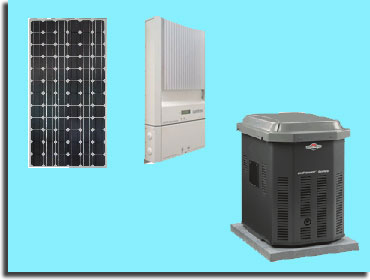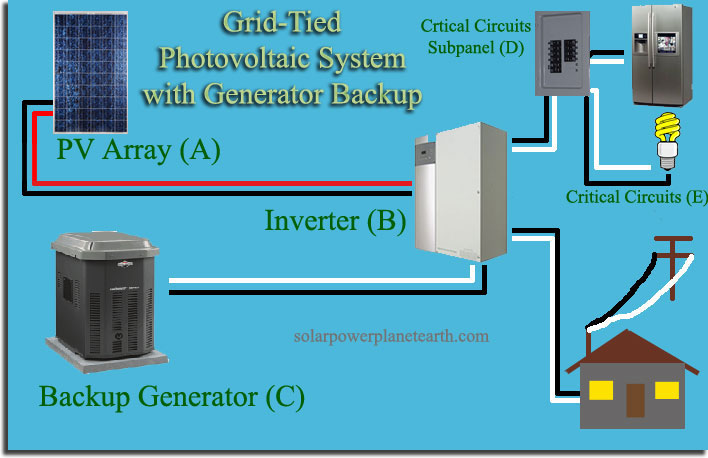 |
Solar Power System with Generator Backup
Although our utility grids are very reliable now-a-days, having backup power associated with your solar power system can still be desireable for peace of mind. Heavy wind and rain, earthquakes, and floods, are only a few among the many things that can still cause the grid to fail for extended periods of time. In a normal grid-tied solar system, if the grid goes down for any reason, so does your solar system. Both battery backup and generator backup have added costs associated with them; however, if you don't mind the extra maintenance and don't want the additional expense associated with having to replace batteries every 5 to 10 years, a generator may be more appealing. Here is the basic configuration of a grid-tied solar system with generator backup:

(A) Photovoltaic Array
The solar contractor will size your array in the same manner as a grid-tied solar system, since the generator has no relevance unless the utility power goes out.
(B) Inverter
Under normal circumstances, the inverter will function in the same manner as a standard grid-tied inverter. In the event of a grid power failure, the inverter will disconnect your solar back-feed (a.k.a. anti-islanding) and immediately switch on the generator. The generator will then provide power to your critical circuit subpanel (D) until its fuel source is exhausted.
(C) Backup Generator
The backup generator can use a number of different types of fuel such as natural gas, gasoline, diesel, or propane. Each of these different types of fuel have advantages and disadvantages associated with them. The most common type of generator for small scale residential systems is natural gas. This allows the generator to be plumbed into the readily available supply of natural gas coming from the utility company. This type of generator requires the least maintenance, since you don't have to worry about fuel going bad if not used, or having to refuel it at all for that matter. Only periodic running of the generator is needed, which is the same for all the other generator types as well. Here is a table which breaks down the differences between the different fuel sources, in addition to comparison to a solar system which uses battery backup.
| Natural Gas | Gasoline | Diesel | Propane | Solar with Battery Backup | |
|---|---|---|---|---|---|
| Requires refueling after use | No |
Yes | Yes | Yes | N/A |
| Requires periodic fuel replacement | No | Yes | Yes | No | N/A |
| Dependent on Utility Company | Yes | No | No | No | No |
| Periodic Maintenance | Yes | Yes | Yes | Yes | No |
| Able to use power from solar panels during grid failure | No | No | No | No | Yes |
As you can see from the table above, the one big disadvantage to using a generator as backup with a solar power system is that you can not take advantage of the energy generated by your solar panels. This is only possible with a solar system with battery backup.
(D) Critical Circuit Sub Panel
This panel will contain all the circuit breakers which lead to your critical circuit loads. These loads will always have power, regardless of grid status. It is important to note, that power will only be drawn from your generator in the event of a grid failure.
(E) Critical Circuits
This set of critical loads can be anything the user wants, such as a refrigerator, lighting, security systems, etc.
A grid-tied solar power system with a backup source is not as common due to the significant increase in total cost, which ultimately reduces your financial return. However, it will give you peace of mind knowing you will never be without power.